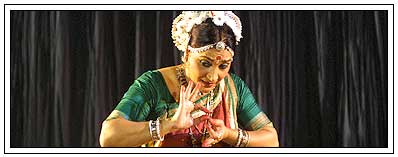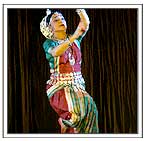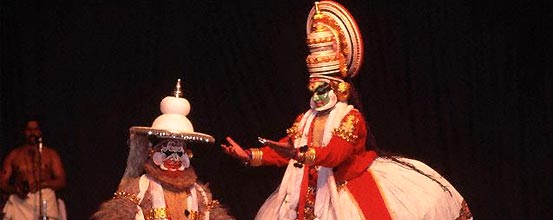





|
Odissi Dance

Odissi is a continued tradition of ancient ‘Odra
Natya’, a music - synchronised dance that existed 2000 years ago. Its
history is linked with the culture of Devadasis (dancing girls) attached to
temple traditions of Orissa. When entire India was following the practice of
Devadasis i.e. consecrating dancing girls in honour of Gods, Orissa remained
not in exception. It started with the Shiv temples in Bhubaneswar as is known
from the inscriptions of the Megheswar Temple (1045 – 1190 AD). Following
the tradition were ‘Maharis’ attached to the Jagannath Temple at
Puri by the Ganga rulers during early 12th cent. AD. Chodaganga Deva, a great
patron of Art and music appointed a number of Devadasis for the ritual –
services of the Lord. In 1435 AD Kapilendra Deva the ruler of Solar Dynasty
regulated the services of the dancing girls and Prataprudra Deva as known from
an inscription of July 1499 AD regulated the performance of dancing stating
that the dancing girls were to dance and sing only from the Geeta-Govinda at
the time of food-offering (Bhoga) in the Jagannath Temple. Ramananda Ray, the
Vaishnavite minister of Prataprudra Deva being a master in dance, drama, music
and poetry was to impart regular training on dance and drama to the Devadasis
of the Jagannath temple. Dancing, though then was an art of honour was not confined
to the Devadasis alone; even the princesses as evident from the commemorative
inscriptions of the Ananta Basudeva Temple (1278 AD) at Bhubaneswar were admitted
to dancing. This tradition had a setback due to political turmoil in Orissa
during the end part of 16th cent. AD for a period of 300 years till the discovery
of ‘Abhinaya Chandrika’ the code of Odissi Dance written in 15th
Cent. AD was discovered by Sri Maheswar Mohapatra. During this period Devadasi
tradition ceased to be respected and dances of ‘Gotipua’ and ‘Sakhipila’
(boys dressed as girls) came in its place to cater the fun loving public.

Odissi is religious based and devotional in character. It embraces both Nrittya
(pure dance) and “Nrutya” i.e. the interpretative dance. The theme
is based on religion and mythology and the urge is equally spiritual and aesthetic.
The dance suffused in spiritual fervour to which the tune is set. Odissi is
a five piece dance opens with “Mangalacharan” and ends on “Mokshya”
having “Batu Nrutya”, “Pallavi” and “Abhinaya”
is between in order. “Mangalacharan” is an invocatory dance followed
by singing a sloka is honour of Lord Ganapati or Jagannath. “Batu Nrutya”
is a pure dance to the rhythms of the “Tals” in poses copied from
rich Orissan sculptures. The most graceful item of the dance is “Pallavi”
usually set to a particular “Raga” to evoke lyrical and sensuous
effects. “Abhinaya” follows “Pallavi” where the dancer
acts to a song either in Oriya or Sanskrit on the eternal love episode of Radha
and Krishna. Popular are the pieces from Geeta Govinda or Dasavatar. Set to
the slow tempo, a dancer successfully depicts the emotion by gesture, glances
and agile movements of the parts of the body to entrap the audience. “Mokshya”
is a contrast to “Abhinaya” which is danced in first tempo. Speed,
intricate rhythm and acting of the dance carries the dancer to the ultimate
end. Romantic songs on various “Ragas”, rhythm, steps to intricate
“Tals” and numerous elegant poses drawn from temple sculptures of
Orissa, all are choreographed to a highly stylised dance i.e. Odissi. The poses
known as “Bhangis” are based on the “Tribhanga” or three-bend
concept of Hindu iconography. The approved bends of the body normally takes
place at legs, waist and head inclined to a side. In the pure form, body line
and manner of performance gets priority in the dance to make it distinct.
|









